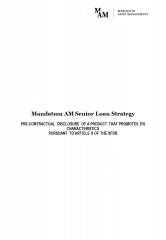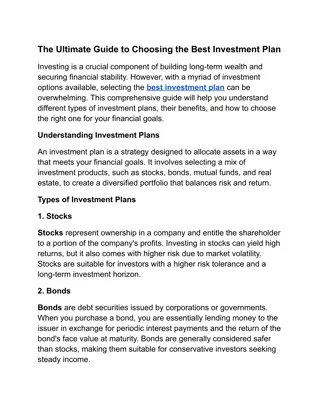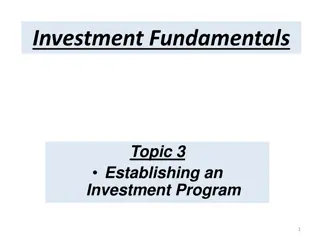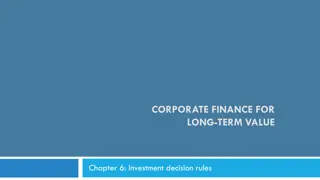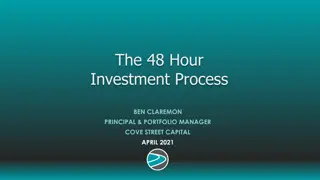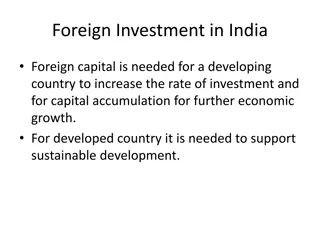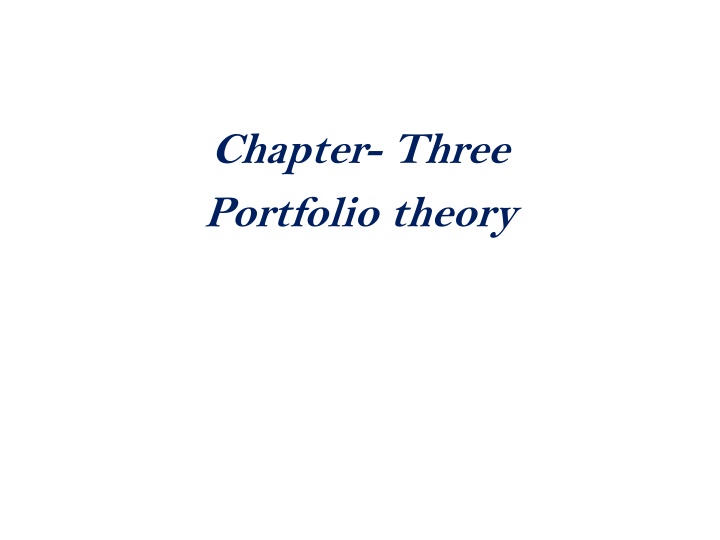
Asset Allocation and Diversification Strategies
Asset allocation involves selecting the mix of asset classes in an investment portfolio to optimize returns while minimizing risk. It plays a crucial role in an investor's success, with up to 90% of a portfolio's return attributed to asset allocation. Diversification, a key concept, focuses on spreading investments within asset classes for risk management. Learn how asset allocation and diversification can enhance your investment strategy.
Download Presentation

Please find below an Image/Link to download the presentation.
The content on the website is provided AS IS for your information and personal use only. It may not be sold, licensed, or shared on other websites without obtaining consent from the author. If you encounter any issues during the download, it is possible that the publisher has removed the file from their server.
You are allowed to download the files provided on this website for personal or commercial use, subject to the condition that they are used lawfully. All files are the property of their respective owners.
The content on the website is provided AS IS for your information and personal use only. It may not be sold, licensed, or shared on other websites without obtaining consent from the author.
E N D
Presentation Transcript
Chapter- Three Portfolio theory
3.1 Diversification and asset allocation An asset allocation focuses on determining the mixture of asset classes that is most likely to provide a combination of risk and expected return that is optimal for the investor. Asset allocation is diversification. It focus on investment in various asset classes. Diversification, in contrast, tends to focus more on security selection securities to be held within an asset class. a bit different from selecting the specific
Cont Asset classes here is understood as groups of securities with similar characteristics and properties (for example, common stocks; bonds; derivatives, etc.). Asset allocation proceeds other approaches to investment portfolio management, such as market timing (buy low, sell high) or selecting the individual securities which are expected will be the winners . These activities may be integrated in the asset allocation process. But the main focus of asset allocation is to find such a combination of the different asset classes in the investment portfolio which the best matches with the investor s goals expected return on investment and investment risk.
Cont Asset allocation largely determines an investor s success or lack thereof. In fact, studies have shown that as much as 90 % or more of a portfolio s return comes from asset allocation. Furthermore, researchers have found that asset allocation has a much greater impact on reducing total risk than does selecting the best investment vehicle in any single asset category.
Cont The term asset allocation is often used to describe the money management strategy that designates how capital should be distributed within an investment portfolio. Typically this involves identifying how much of the portfolio should be distributed into various asset classes, or broad types of investments such as stocks, bonds, commodities, and cash.
Cont The objective of asset allocation is to optimize the mix of the investments into different asset classes in order to maximize the return of the investment portfolio while minimizing the potential risk, based on an investor's timeframe, risk tolerance, and long-term investment goals. Evidence suggests that certain asset classes perform better or worse depending on economic conditions, market forces, government policy, and political influence. The goal of an asset allocation strategy is to identify these conditions and allocate resources appropriately.
Cont A concept that is closely associated with asset allocation is diversification , and in practice, these terms are often used interchangeably. Asset allocation, however, concerned with allocating capital into different asset classes. For example, a typical asset allocation strategy might dictate that your portfolio should have 50% invested in stocks, 30% invested in bonds, 10% in commodities, and 10% in cash. is principally
Cont Diversification is typically associated with the allocation of capital within those asset classes. For example, within the stock allocation of the same portfolio, investments could be allocated to 50% large-cap stocks, 20% mid-cap stocks, 10% small-cap stocks, 10% international stocks, and 10% emerging market stocks. The concept of diversification distribution of assets within individual asset classes while risk is distributed among the asset classes of the overall portfolio, diversification reduces risk within each asset class. involves the
Cont The Asset Allocation Decision: Factors to consider in making the asset allocation decision include the investor's return requirements (current income versus future income), the investor's risk tolerance, and the time horizon. This is done in conjunction with the investment manager's expectations about the Capital markets and about individual assets. How asset allocation decisions are made by investors remains a subject that is not fully understood. It is known that actual allocation decisions often differ widely from how investors say they will allocate assets.
Cont Types of Asset Allocation: Two categories in asset allocation are defined: 1. Strategic asset allocation 2. Tactical asset allocation 1. Strategic asset allocation identifies asset classes and the proportions for those asset classes that would comprise the normal asset allocation. Strategic asset allocation is used to derive long-term asset allocation weights. The fixed-weightings approach in strategic asset allocation is used. Investor using this approach allocates a fixed percentage of the portfolio to each of the asset classes, of which typically are three to five.
Cont Example of asset allocation in the portfolio might be as follows: Asset class Allocation Common stock 40% Bond 50% Short-Term Securities 10% 100% Total Portfolio
Cont Generally, these weights are not changed over time. When market values change, the investor may have to adjust the portfolio annually or after major market moves to maintain the desired fixed-percentage allocation.
Cont 2. Tactical asset allocation produces temporary asset allocation weights that temporary changes in capital market conditions. The investor s goals and risk- return preferences are assumed to remain unchanged as the asset weights are occasionally revised to help attain the investor s constant goals. For example, if the investor believes some sector of the market is over- or under valuated. The passive asset allocation will not have any changes in weights of asset classes in the investor s portfolio the weights identified by strategic asset allocation are used. occur in response to
Cont Alternative asset allocations are often related with the different approaches to risk and return, identifying conservative, moderate and aggressive asset allocation. The conservative allocation- is focused on providing low return with low risk; The moderate average return with average risk and the aggressive high return and high risk. The example of these alternative asset allocations is presented in the following table.
Cont Comparison between the alternative asset allocations Alternative asset Allocation Asset class Conservative Moderate Aggressive Common stock 20% 35% 65% Bond 45% 40% 30% Short-Term Securities Total Portfolio 35% 25% 5% 100% 100% 100%
MARKOWITZ PORTFOLIO SELECTION MODEL/THEORY Harry Markowitz opened the door to modern portfolio theory. He started with the idea of risk aversion of average investors and their desire to maximize the expected return with the least risk. Markowitz is a theoretical framework for analysis of risk and return and interrelationships. He used the statistical analysis for measurement of risk and mathematical programming for selection of assets in a portfolio in an effective manner. His framework led to the concept of efficient portfolios. An efficient portfolio is expected to yield the highest return for a given level of risk or lowest risk for a given level of return.
Contd Markowitz has generated a number of portfolios within a given amount of money or wealth and given preferences of investors for risk and return. Given the preferences, the portfolio selection is not a simple choice of any one security or securities, but a right combination of securities. He emphasized that quality of a portfolio will be different from the quality of individual assets within it. The expected return/yield may vary depending on the assumptions.
Contd To select an optimal portfolio of financial assets using the Markowitz analysis; investors should; 1. Identify optimal risk-return available from the set of risky assets being considered by using the Markowitz efficient frontier analysis. This step; uses the inputs from, the expected returns, variances, and covariance for a set of securities. 2. Choose the final portfolio from among those in the efficient set based preferences. combinations on an investor's
Cont Assumptions of the Markowitz Portfolio Selection Model: 1. A single investment period; for example, one year. 2. Liquidity of positions; for example, there are no transaction costs. 3. Investors are rational and behave in a manner as to maximize their yield utility with a given level of income or money. 4. Investors have free access to accurate and current information on the returns and risk. 5. The markets are efficiently and absorb the information quickly and perfectly. 6. Investors are risk averse and try to minimize the least risk and maximize high return.
Contd 5. Investors base decisions on expected returns and variance or standard deviation of returns only. 6. For a given risk level, investors prefer high returns to lower returns. Under these assumptions, a single asset or portfolio of assets is considered to efficient if no other asset or portfolio of assets offers higher expected return with the same (or lower) risk or lower risk with the same (or higher) expected return.
Cont Efficient Portfolios: Markowitz's Approach to portfolio selection is that an investor should evaluate portfolios on the basis of their expected returns and risk as measured by the standard deviation. He was the first to derive the concept of an efficient portfolio, defined as one that, has the smallest portfolio risk for a given level of expected return or the largest expected return for a given level of risk. Rational investors will seek efficient portfolios, because these portfolios are optimized on the two dimensions of most importance expected return and risk. to investors,
Cont Selecting an Optimal Portfolio of Risky Assets: Once the efficient set of portfolios is determined using the Markowitz model, investors must select from this set the portfolio most appropriate for them. The Markowitz model does not specify one optimum portfolio. Rather it generates the efficient set of portfolios, all of which, by definition; are optimal portfolios (for a given level of expected return or risk).
Cont The Single - Index Model: William Sharpe, following Markowitz, developed the single- index model, which relates returns on each security to the returns on a common index. A broad market index of common stock returns is generally used for this purpose. The single-index model can be expressed by the following equation: Ri = i + iRM + i Where; Ri = the return (TR) on security i RM = the return (TR) on the market index: i = that part of security i s return independent of market performance i = a constant measuring the expected change in the dependent variable, Ri given a change in the independent variable, RM i = the random residual error;
Cont The single-index model divides a security's return into two components: a unique part, represented by i and a market related part represented by iRM. The unique part is a micro event, affecting an individual company but not all companies in general. Examples include, a fire, a strike, or the resignation of a key company figure. The market related part, on the other hand, is a macro event that is broad based and affects all (or; most) firms. Examples include a Federal Reserve announcement about the discount rate, a change in the prime rate, or an unexpected announcement about the money supply.
Cont Given these values, the error term is the difference between the left-hand side of the equation and right-hand side of the equation. Since the single-index model is, by definition, equality, the two sides must be the same.
Cont Selecting Optimal Asset Classes the Asset Allocation Decision: The Markowitz model is typically thought of in terms of selecting portfolios of individual securities; indeed, that is how Markowitz expected his model to be used. As we know, however, it is a cumbersome model to employ because of the number of covariance estimates needed when dealing with a large number of individual securities. An alternative way to use the Markowitz model as a selection technique is to think in terms of asset classes, such as domestic stocks, foreign stocks of industrialized countries, the stocks of emerging markets, bonds, and so forth. Using, the model in this manner, investors decide what asset classes to own and what proportions of the asset classes to hold.
Cont The allocation of a portfolio's funds to classes of assets, such as cash equivalents, bonds, and equities The asset allocation decision refers to the allocation of portfolio assets to broad asset markets; in other words, how much of the portfolio's funds are to be, invested in stocks, in bonds, money market assets, and so forth. Each weight can range from zero percent to 100 percent. Asset allocation is one of the most; widely used applications of modern portfolio theory(MPT).
Cont Examining the asset allocation decision globally leads us to ask the following questions: 1. What percentage of portfolio funds is to be invested in each of the countries for which financial markets are available to-investors? 2. Within each country, what percentage of portfolio funds is to be invested in stocks, bonds, bills, and other assets? 3. Within each of the major asset classes, what percentage of portfolio funds is to be invested in various individual securities?
Cont Many knowledgeable market observers agree that the asset allocation decision is the most important decision made by an investor. According to some studies, for example, the asset allocation decision accounts for more than 90 percent of the variance in quarterly returns for a typical large pension fund. The rationale behind this approach is that different asset classes offer various potential returns and various levels of risk, coefficients between some of these asset classes may be quite low, thereby providing beneficial diversification effects. and the correlation
Cont The Impact of Diversification on Risk: The Markowitz analysis demonstrates that the standard deviation of a portfolio is typically less than the weighted average of the standard deviations of the securities in the portfolio. Thus, diversification typically reduces the risk of a portfolio as "the number of portfolio holdings increases, portfolio risk declines.
Cont Systematic and Nonsystematic Risk: The riskiness of the portfolio generally declines as more stocks are added, eliminating the nonsystematic risk, or company- specific risk. This is unique risk related to a particular company. However, the extent of the risk reduction depends upon the degree of correlation among the stocks. Adding more stocks will reduce risk at first, but no matter how many partially correlated stocks we add to the portfolio, we can not eliminate all of the risk. because we are
Cont Variability in a security's total returns that is directly associated with overall movements in the general market or economy is called systematic risk, or market risk, or non diversifiable risk. Virtually all securities have some systematic risk, whether bonds or stocks, because systematic risk directly encompasses interest rate risk, market risk, and inflation risk.
Cont After the non systematic risk is eliminated, what is left is the non diversifiable portion, or the market risk (systematic part). This part of the risk is inescapable, because no matter how well an investor diversifies, the risk of the overall market cannot he avoided. Investors can construct a diversified portfolio and eliminate part of the total risk, the diversifiable or non market, part.
Cont As more securities are added, the non systematic risk becomes smaller and smaller, and the total risk for the portfolio approaches its systematic risk. Since diversification cannot reduce systematic risk, total portfolio risk can be reduced no lower than the total risk of the market portfolio. Diversification can substantially reduce the unique risk of a portfolio. However, we cannot eliminate systematic risk. Clearly, market risk is critical to all investors. It plays a central role in asset-pricing, because it is the risk that investors can expect to be rewarded for taking.
Cont The Implications of the Markowitz Portfolio Model: The construction of optimal portfolios and the selection of the best portfolio for, an investor have implications for the pricing of financial assets. Part of the riskiness of the, average stock can be eliminated by holding a well-diversified portfolio. This means that part of the risk of the average stock can be eliminated and part cannot. Investors need to focus on that part of 'the risk that cannot be eliminated by diversification, because this is the risk that should be priced in the financial markets. The relevant risk of an individual stock is its contribution to the-riskiness of a well diversified portfolio. The return that should be expected on the basis of this contribution can be estimated by the capital asset pricing model.

